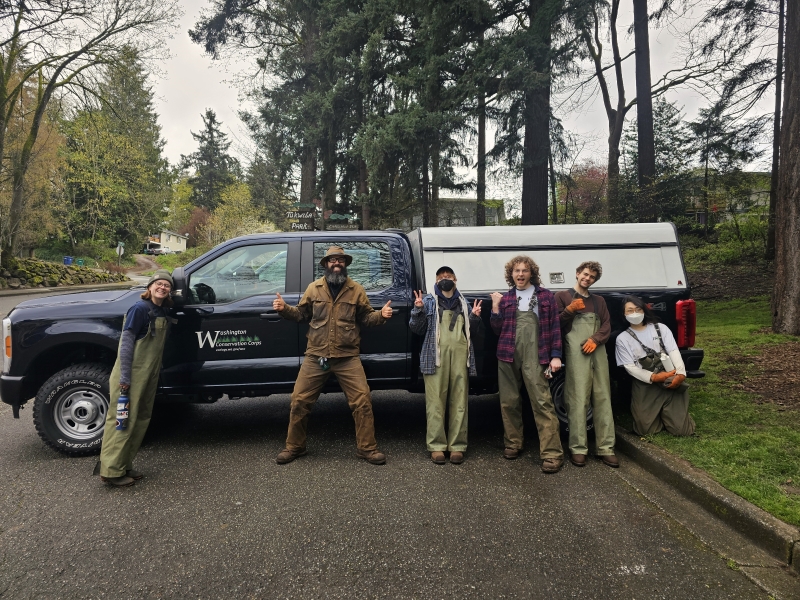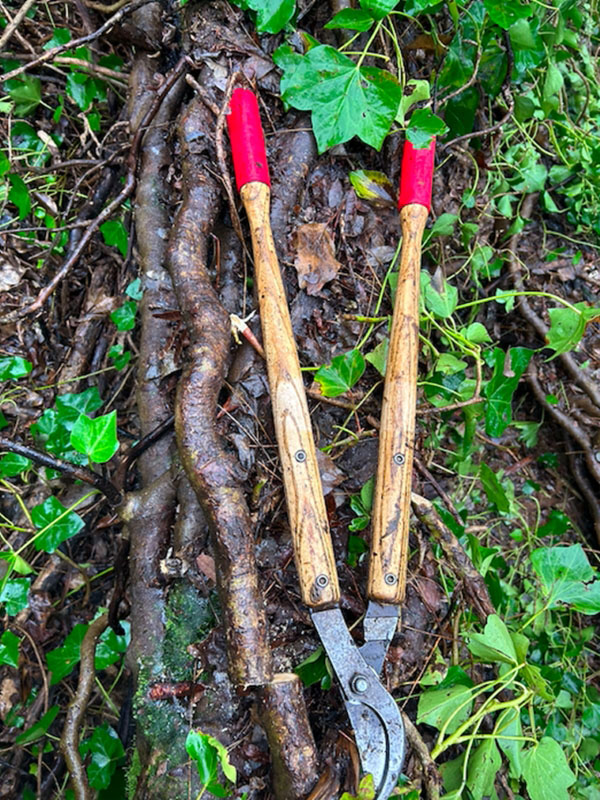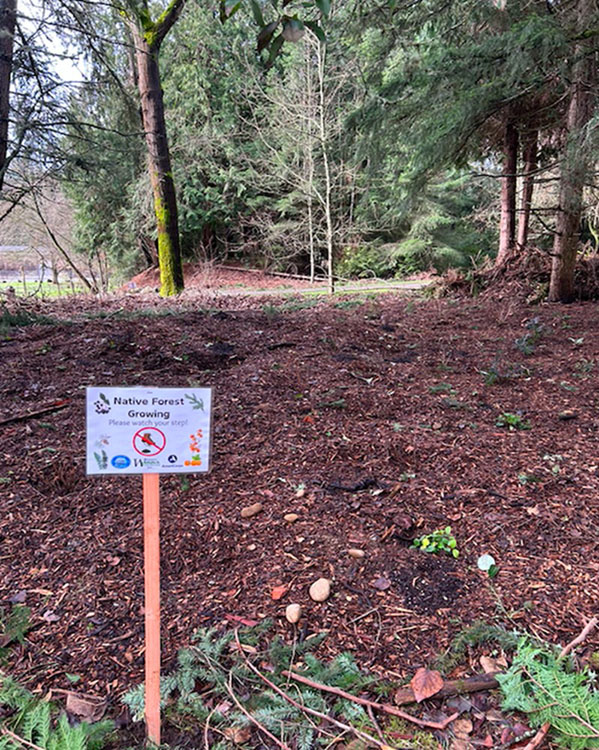When I joined a Washington Conservation Corps (WCC) environmental justice crew in October 2023, I knew what environmental justice was but I didn’t know what it looked like in practice.
As a recent University of Puget Sound graduate with degrees in history and environmental policy, I learned about the inequitable distribution of environmental hazards around Puget Sound.
In my senior research thesis, I studied Tacoma’s copper refining smelter operations in the 19th and 20th centuries and how its lingering contamination transformed the landscape. Air pollution from the smelter settled on the surface soil of more than 1,000 square miles of the Puget Sound basin. Arsenic, lead, and other heavy metals are still in the soil because of this pollution.
I learned about environmental justice as the work of lessening these environmental harms, and I was excited to see that work in practice on a WCC field crew.
WCC's South King County crew. From left to right: Lauren, Andrew M., Jupiter, Andrew P., Fletcher, and Cat.
Washington’s Healthy Environment for All Act aims to advance environmental justice by providing communities with equitable access to healthy environments in which to live, learn, and work. Access to healthy green spaces is known to improve mental health, boost climate resilience and improve air and water quality, and help retain groundwater.
People without access to healthy green spaces may experience a lower quality of life and shorter life expectancy. Often, areas that lack access to green spaces reflect redlining and other discriminatory housing policies that disproportionately impacted people of color and low-income households. Environmental justice incorporates this history while investing in a healthier future in places that need it the most, for communities who have the most to gain.
Environmental justice in action
My WCC crew partners with the cities of Burien, Seatac, and Tukwila in south King County. These municipalities are facing greater health risks and disparities from environmental hazards including noise and air pollution from the Seattle-Tacoma International Airport, U.S. Interstate 5 corridor, and a high concentration of industrially zoned areas along the Duwamish River.
An example of 'old growth' ivy climbing up a tree.
To combat some of these hazards, the cities formed “Green” partnerships where city governments, businesses, and nonprofit organizations have come together to create a plan for local green spaces. While funding for hands-on conservation efforts in these spaces is often limited, WCC’s environmental justice program offers field crew support for projects like this at no cost.
We support these green spaces primarily by managing invasive species. Non-native plants like Himalayan blackberry and English ivy have a stronghold in many parks and are known to take over ecosystems, outcompete native plants, and decrease biodiversity throughout the food chain. In some parks we visit, invasive species have run rampant for years without adequate resources to maintain them.
Our crew has encountered what we call 'old growth' ivy climbing up trees in Seahurst Park, Tukwila Park, and North SeaTac Park. We’ve cleared carpets of ivy blanketing forest floors and fought through seemingly impenetrable (and very prickly!) blackberry brambles. But, beneath these invasive species, we’ve uncovered diverse, resilient ecosystems and forest critters.
In Tukwila Park — located less than half a mile from Westfield Southcenter Mall — we found an abundance of northwestern salamanders. These small creatures are considered an indicator species, meaning their presence provides tangible evidence of a functioning ecosystem. We’ve also uncovered abundant understories of native plants like salal, low Oregon grape, snowberry, and sword fern.
We've encouraged additional biodiversity through native plantings. Since October 2023, we've planted more than 1,600 native trees, shrubs, and understory plants between our three partner cities.
Building a better future
A northwestern salamander found at Tukwila Park.
In Tukwila, only 2 percent of the city’s total area is designated as parks and natural areas, many of which are affected by forest fragmentation. Impermeable surfaces like concrete and rooftops make up 48 percent of the city. When green spaces are separated by development, roads, or even sports fields, it limits the natural dispersal of native plants and animals — leaving them more vulnerable to encroaching invasive species and human activities.
Tukwila’s stewardship plan acknowledges that the loss of tree canopy has enabled invasive plants to dominate much of the city’s natural areas and prevent new tree and understory growth. Intervention is needed to keep young native trees present in the understory and ensure that the next generation of canopy can thrive. Right now, even if new saplings are planted, they may not be able to establish themselves in such a disturbed ecosystem.
My crew has two main goals in these parks — remove invasive species and open up areas so new, native plants have a chance to grow and integrate into the ecosystem. This requires continued maintenance to prevent invasive species from spreading into previously cleared areas. Due to forest fragmentation, invasive species will often spread from adjacent, privately owned land. Another component of our restoration is encouraging people to remove these non-native invasive plants from around their homes.
WCC members transplanting native plants at a restoration site.
Looking ahead
Although these green spaces face challenges, urban canopies continue to teach us resiliency. During my term, I’ve gained a deeper appreciation and understanding of the natural world around me. I’ve learned about native plants in the region and had the opportunity to share my knowledge with students at local middle and high schools. I love serving outside and getting to appreciate the seasonality of a place — seeing the parks transform over the time has been so rewarding.
Through our partnership with Burien, SeaTac and Tukwila, we have met people working to make parks healthier and more accessible. We’ve seen community members enjoying these spaces in new ways, rediscovering what’s in their backyard, and learning about native plants for the first time. I’ve come to love the parks and green spaces we serve in — many of which could be easily overlooked by their size relative to other city parks. Being a part of WCC’s environmental justice initiative has opened my eyes to the contribution of every green, no matter how small, space to a healthier and more balanced world.
Once my time with WCC is complete, I hope to continue the path of environmental education and urban forestry by working to ensure everyone has access to the systemic, positive effects of green spaces. For our crew, environmental justice means protecting and advocating for these green spaces — and in turn, they enhance our lives and the communities surrounding them.
Meet the crew
To take a lesson from the forest on the importance of collaboration, I asked the rest of my crew what environmental justice and urban park restoration mean to them:
Jupiter, crew member
“People in urban environments deserve to see what a healthy ecosystem looks like — a lot of urban ecosystems are highly sterilized and especially with climate change, it’s so important for people of all ages and backgrounds to see a healthy system.”
One of several signs posted at SeaTac Park to denote WCC restoration sites.
Andrew M., crew supervisor
“I like that you can make a tangible difference for the community and the landscape. Working outside can sometimes be abstract, but here, we know people are using this space and we can see the difference. A big way to get people to care about the environment is to expose them to it.”
Andrew P., crew member
“Growing up in Houston, Texas, I became intimately aware of the negative mental health effects that come from not having access to green space. The parks we serve in are extremely important resources everyone should have access to, and being a part of their restoration has been fulfilling.”
Fletcher, crew member
“Parks allow us to spend time in nature and urban parks can give us a glimpse into native habitat. It is satisfying to reveal the native plants underneath all the blackberry and ivy and restore what was there all along.”
Cat, crew member
"Restoring urban greenspaces means making our human world more intentionally porous, reawakening rather than destroying the ancient relationships between the flowers and critters that we've never been able to survive without. We protect pollutant-filtering forests that will lengthen people's lives, and out of seas of ivy, we clear beautiful third places where people can breathe, pray, and enjoy delicious native berries. I think that's kinda fun."
Join WCC
WCC is currently recruiting members (18-25 years old and military veterans) for our summer term! Join us outside this summer and gain hands-on career skills while supporting environmental restoration and outdoor recreation projects around Washington. Our summer term begins June 10 and runs through Sept. 5, 2024. Positions are limited, so we recommend applying early to ensure consideration.

